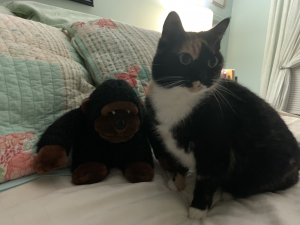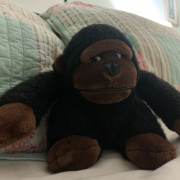It’s a surprisingly moving cinematic moment, when delivered as beautifully as this one is, to see an older man connect to a younger one by asking about his favorite stuffed toy from childhood. The older man is the legendary Fred Rogers, played by Tom Hanks in the hit movie It’s a Beautiful Day in the Neighborhood. Mr. Rogers is trying, in his quiet, measured manner, to befriend a cynical young journalist named Tom, played by actor Matthew Rhys. Tom has been assigned, over his angry objections, to write a short magazine profile on Mr. Rogers as an American hero. He is bitterly skeptical that this red-sweater-wearing star of children’s television should be anyone’s hero, anything like the character on the screen, so kind, so gentle, so beloved by so many.
Waving a worn, familiar puppet, a regular character on the show, Mr. Rogers responds to one of Tom’s interview questions with one of his own. “Did you have a special friend like this when you were a child, Tom?” Yes, the annoyed writer responds, testily. Now can we get back to the interview?
“What was his name, Tom?” Mr. Rogers persists. Rabbit, answers Tom. Suddenly he pauses, struggling with surprise at the catch in his voice when he adds, “Actually, it was Old Rabbit.”
It was one of the quietest moments in the theater during this heartwarmng film. Nearly every adult present surely was thrown back through misty memory to the warm days of childhood, remembering, maybe even longing for, that most special animal. The particular one that is so tightly wound to the heart of so many young children.
Everyone except for me. Instead, I was thinking about the time just a few years back when my mom sent me an ape.
Seven or eight years ago—when I was in my fifties, mind you—I had some minor surgery. It was nothing unusual, but I dreaded it, and I told Mom as much a few days before the procedure. “You’ll do fine,” she assured me, “and we’ll check on you.” My sister, a registered nurse, accompanied me to the procedure and hung around a day or two to make sure I was following instructions from the doctor. The next day, the mailman brought a little package showing my parent’s return address. This produced a smile from the patient. Ripping into the box, I thought: Chocolate, to sweeten the long post-op hours? One of my mother’s baubles, to hand down, maybe?
It was a small stuffed ape, a chimpanzee, I guess. About six or eight inches high, he commands a permanent seated position, his fat, velvety feet pointed ever upward. The plump hands at the end of his long arms feature Velcro strips in the palms, in case you want to walk around with him hugging your wrist, like a designer purse. Most intriguing of all, his eyes are fixed in a sideways glare that is part surprise, part wariness, and part sarcasm, like he has just rolled them upward at your lame joke.
My sister and I looked at each other, puzzled. My mother’s gift selections have been at times renowned in the family for, shall we call it, creativity. Still, this was a rather surprising selection for a post-op patient. What on earth? I said, and my sister just shrugged, unsurprised. I named him Harry, after my mother’s father, an uncle of the same name, and also because he’s a…well, you get the idea.
Hey, Mom, thanks for the little ape, I chirped the next time she called to check in. What, um, what made you think to send me this? “Oh, I just thought he was cute,” she said cheerfully. “Now, when do you get your stitches out?”
It was borne in on me long ago that it would be wise to emulate my mother’s habit of not over-thinking things, so I moved on along to her destinations for the conversation. Harry soon took up residence on my bed, about four decades after a stuffed animal had last been found there. He perches in front of the fancy pillow shams, directly facing the corner spot where the cat spends about half her life dozing. (If she is unsettled by the presence of an ape nearby, she has never mentioned it.) Sometimes Harry serves as an excellent prop for an open book, his wide feet pointed at just the right angle to boost up the lower edge of the cover. My grandkids occasionally relocate Harry to the guest room for the night; he serves as an excellent stand-in if they are sleeping over and forgot their own favorite friend. And if I am fully forthcoming about Harry’s occupation here, I must admit he has been tear-soaked through more than one episode of deep grief, when my sister died a couple of years after that surgery, my father soon after, and my beloved old dog more recently.
My grandkids have never questioned why their grandmother would have a small stuffed ape on her bed and would share him as needed. Instinct probably tells them what special grownups like Mr. Rogers and my mother also know—that if we are lucky, and open to it, we let the lovelights of childhood continue to illuminate adult hearts. The tender desires of the very young—for love, comfort, simplicity, friendship, self-respect, encouragement—don’t really change with time. Once in a while, when buffeted by adult-world difficulties, we might need a small symbol to remind us of that. Mr. Rogers knew it. My mother would never give herself credit for such an insight, but she knows it, too.
Then there’s Harry to remind me, sitting patiently his post, watching carefully out of that side-eye glare.


